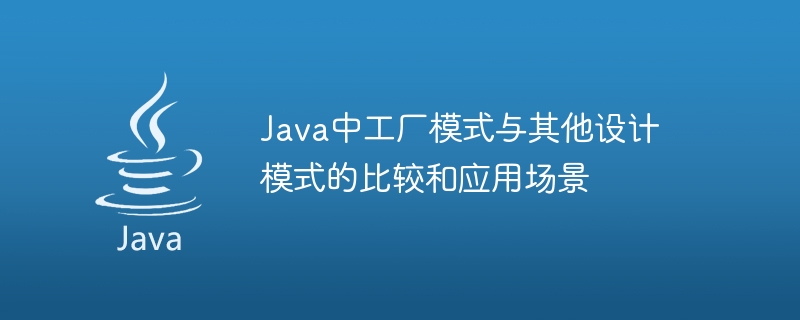

Comparison and application scenarios of factory pattern and other design patterns in Java
In the software development process, the design pattern is a proven and reusable design pattern A solution describes a set of interrelated classes and objects to solve a specific software design problem. Design patterns can help developers better organize and manage code, and improve code readability, maintainability and scalability. In Java, there are many commonly used design patterns, among which the factory pattern is a very important and commonly used design pattern.
Factory pattern is a creational design pattern that provides a best practice for creating objects. It defines an abstract factory, which is used to create concrete factory objects, and the concrete factory implements the interface of the abstract factory and is responsible for creating specific product objects. The factory pattern makes the system more scalable by separating the creation and use of objects, and makes the code more flexible and easier to maintain.
Similar to the factory pattern are the abstract factory pattern and the singleton pattern. The abstract factory pattern adds the concept of product family to the factory pattern. It abstracts the creation of products into abstract methods, which are implemented by specific product factories. The singleton pattern can only create one instance object. It privatizes the construction method to ensure that the object can only be created in a specific way.
Below we use specific code examples to demonstrate the comparison and application scenarios of the factory pattern and other design patterns. Suppose we need to create a calculator class that includes two operations: addition and multiplication.
First, let’s look at the situation of creating a calculator using the ordinary method:
public class Calculator { private int num1; private int num2; public Calculator(int num1, int num2) { this.num1 = num1; this.num2 = num2; } public int add() { return num1 + num2; } public int multiply() { return num1 * num2; } }
In this case, we write the logic of creating the object directly in the Calculator class, resulting in if needed To add other calculation methods, you need to modify the code of the Calculator class. This destroys the scalability and maintainability of the code.
Next, we use the factory pattern to refactor:
First, create an abstract factory interface CalculatorFactory:
public interface CalculatorFactory { Calculator createCalculator(); }
Then, create the concrete factory classes AdditionFactory and MultiplicationFactory:
public class AdditionFactory implements CalculatorFactory { private int num1; private int num2; public AdditionFactory(int num1, int num2) { this.num1 = num1; this.num2 = num2; } public Calculator createCalculator() { return new Calculator(num1, num2) { public int calculate() { return num1 + num2; } }; } } public class MultiplicationFactory implements CalculatorFactory { private int num1; private int num2; public MultiplicationFactory(int num1, int num2) { this.num1 = num1; this.num2 = num2; } public Calculator createCalculator() { return new Calculator(num1, num2) { public int calculate() { return num1 * num2; } }; } }
Finally, use the factory pattern to create the calculator object:
public class Main { public static void main(String[] args) { CalculatorFactory additionFactory = new AdditionFactory(2, 3); CalculatorFactory multiplicationFactory = new MultiplicationFactory(2, 3); Calculator additionCalculator = additionFactory.createCalculator(); Calculator multiplicationCalculator = multiplicationFactory.createCalculator(); System.out.println("Addition: " + additionCalculator.calculate()); System.out.println("Multiplication: " + multiplicationCalculator.calculate()); } }
Through the factory pattern, we abstract the logic of creating objects, and the specific factory class is responsible for creating different calculator objects, thus Implemented code separation and decoupling. If you need to add other calculation methods, you only need to create the corresponding specific factory class.
To sum up, the factory pattern is a very important and commonly used design pattern that can improve the scalability and maintainability of the code. Compared with the abstract factory pattern and the singleton pattern, the factory pattern is mainly used to create objects, while the abstract factory pattern is used to create objects of the product family, and the singleton pattern is used to create singleton objects. In actual development, choosing the appropriate design pattern according to specific needs and scenarios can improve the quality and maintainability of the code.
The above is the detailed content of Comparison and application scenarios: Comparison of factory pattern and other design patterns in Java. For more information, please follow other related articles on the PHP Chinese website!
 How to turn two pages into one word document
How to turn two pages into one word document What are the virtual currencies that may surge in 2024?
What are the virtual currencies that may surge in 2024? What file is .exe
What file is .exe The difference between Hongmeng system and Android system
The difference between Hongmeng system and Android system What are the tips for using dezender?
What are the tips for using dezender? createprocess failure reason
createprocess failure reason How to solve the problem of vs2008 installation failure
How to solve the problem of vs2008 installation failure How to make money with blockchain
How to make money with blockchain



